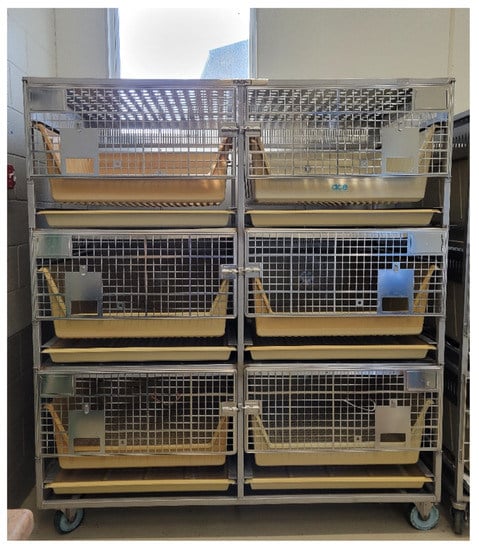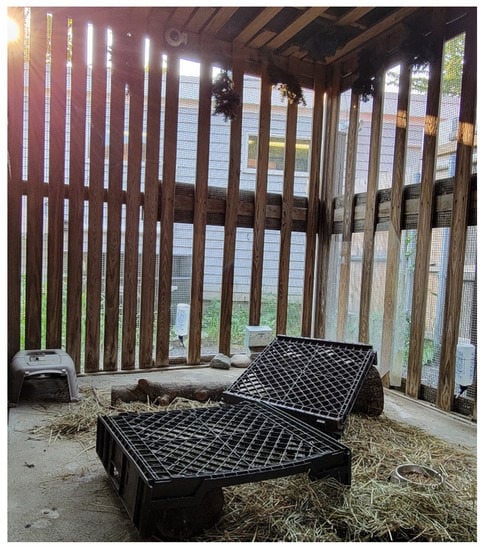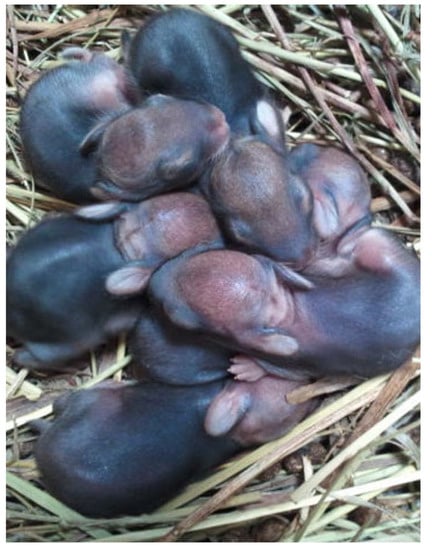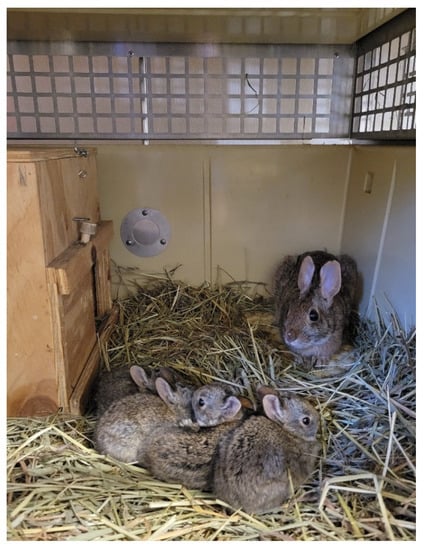Abstract
As part of a science-based conservation strategy for the New England cottontail (NEC), Roger Williams Park Zoo (RWPZ), located in Providence, Rhode Island, participates in a NEC ex situ breeding program in partnership with the NEC Population Working Group. RWPZ’s role is to not only breed vulnerable cottontail rabbits for eventual release to bolster wild populations, but also to help foster research on a species that is hard to observe naturally. RWPZ was the first to breed this species in a zoological facility, playing a significant role in the survival of New England’s only native rabbit.
1. Introduction
The New England cottontail (NEC) (Sylvilagus transitionalis) is a threatened rabbit species (listed as Vulnerable on the IUCN Red List) that used to range throughout much of New England. It is now found only in isolated subpopulations in Connecticut, Massachusetts, Maine, New York, New Hampshire, and Rhode Island. In the latter two states, populations in 2015 were estimated to be less than 180 and less than 100 individuals, respectively [1]. This species requires early successional habitat which is being lost through land development, succession, and suppression of natural disturbances (i.e., wildfires, flooding). NEC numbers have been in decline for decades and, without assistance, the genetic diversity of the remaining isolated populations will continue to decrease as well. They may also be losing the competition for resources with the non-native eastern cottontail (Sylvilagus floridanus), which was introduced from Missouri in the 1930′s to benefit hunters [2].
There are many partners in the overall recovery effort working to create or restore early successional habitat on public and private lands in order to expand and reconnect isolated NEC populations [Appendix A]. The missing factor was a source of genetically diverse NECs to (re)populate these areas. In 2010, state biologists reached out to Lou Perrotti, Director of Conservation Programs, and zookeepers at Roger Williams Park Zoo (RWPZ) who had the facilities and expertise to facilitate a breeding program at the zoo. The NEC Population Management Group, comprised of federal and state level wildlife agencies, funding agencies, state universities, and RWPZ, was formed and tasked with the development of a breeding management program for NEC. This program seeks to breed NECs for release into the wild, with the goal of restoring sustainable population numbers.
Within this program, RWPZ is working with students and professors from various universities, providing data for multiple research projects studying the biology and ecology of NEC rabbits. Using this research, RWPZ can fine tune best practices when it comes to NEC breeding management, and field biologists can gain insight into NEC behavior.
2. Ex Situ Breeding Program
Wild rabbits are trapped in Connecticut, Massachusetts, Maine, New Hampshire, and New York, by state wildlife biologists, and brought to the zoo for breeding. These rabbits are called “founders,” they are assumed to be unrelated and will form the basis of the population. Upon arrival, their fecal samples are collected and sent out to The University of Rhode Island (URI) for genetic testing to confirm they are NECs and not the similar looking non-native eastern cottontail. Rabbits then undergo a 30-day quarantine. During this time, they are monitored for signs of disease and treated for internal and external parasites. As of 2022 they are also tested for tularemia. Provided the rabbits prove to be healthy NECs, they receive ear tags and microchips for identification, are vaccinated against Rabbit Hemorrhagic Disease Virus (RHDV2), and finally receive a full medical exam before moving into the breeding program.
When the founders are not in a breeding situation, they are housed individually indoors in lab-style suspended caging [Figure 1]. Cages are bedded with timothy hay and furnished with a hide box and pieces of woody browse. Water bottles and grain are mounted on the cage door. Husbandry is performed daily: feces are sifted onto the liner, soiled hay is removed and replaced with new, grain hoppers are refilled, water bottles are changed, and fresh greens are given. Cage liners are replaced every other day. The space is climate controlled and has windows to allow for a more natural photoperiod.

Figure 1.
Laboratory-style caging racks. This style of caging, where waste falls through into the liner below, provides a more hygienic space for the rabbits and allows for a much less invasive cleaning style.
Breeding takes place in one of four covered outdoor breeding pens [Figure 2] which are approximately 10′x15′ with a dig proof concrete slab floor and fully meshed sides. Visual barriers are in place between pens to decrease aggression between males. An area of timothy hay is maintained in the center of each pen for both bedding and food. Several hides of assorted sizes are provided for the animals to take shelter together or separately. There are multiple sources for water, grain, and woody browse for them to choose from. Pens are cleaned daily: soiled hay is removed and replaced with new, floors are swept, grain sources replenished, water bottles replaced, and fresh greens are provided. Each pen is fitted with 2 cameras on opposing walls with overlapping fields of view. Camera footage is utilized by students at URI for research.

Figure 2.
Outdoor breeding pen. When rabbits move here for breeding, they are moved in their hide boxes which remain in the pen with them to provide additional cover.
Fecal samples are collected from cages or pens when requested for research studies by URI, or sent to State University of New York, College of Environmental Science and Forestry where they are using them to study stress levels in NECs under managed care.
The exact number of males and females in the program each year varies based on the success of the wildlife biologists’ trapping efforts. The aim is to have 4–5 males and 13–14 females per season. Rabbit pairings are decided based on maximizing genetic diversity; females are assigned to mate with a different male during each round of breeding and each male is assigned a similar total number of females. NEC pairs are put together in the breeding pens for approximately 48 h unless there are signs of aggression. After this breeding opportunity, males may remain outside to mate again while females are brought back inside to their individual cages.
The females are monitored closely during their birthing window. This window begins 27 days after the first day in the breeding pen and ends 40 days after the last day. If kits are born, noise is kept to a minimum and the cage is not disturbed for 3 days except to deliver fresh browse or to remove any deceased kits: no cleaning takes place at this time in an effort to reduce stress on the dam [Figure 3]. These offspring will be released into the wild and so it is important that they are raised by the dam. The staff strives to provide the best care while maintaining a hands-off approach.

Figure 3.
Newborn Kits. A litter of 1-day old kits, eyes shut and ears back. Source: Roger Williams Park Zoo.
Kits remain with the dam until they are weaned at 23 days [Figure 4]. At this time either dam or kits are moved to a new cage and the female can now be bred again. As many breeding rounds as possible are fit into each season, typically starting in February, and ending in August. At the end of the season, some of the adults will be released while those that adapted to the program well and proved to be good breeders may stay at RWPZ for another season. It is important for population genetics to rotate founders so no one rabbit’s genes are overrepresented.

Figure 4.
A dam with her 15-day old kits. The kits will remain with the dam for another 8 days before weaning.
After the kits have been weaned, RWPZ veterinarians begin the process of vaccination against Rabbit Hemorrhagic Disease Virus (RHDV2), identifying their sex, and giving them ear tags and microchips. They also clip a tiny portion of one ear to obtain a DNA sample from each animal. Once kits are tagged and identifiable, they are moved outside to one of the empty breeding pens to help them acclimate to living outdoors. Kits remain at RWPZ until the NEC Population Management Working Group decides where they will be released based on their genetic profile. State wildlife biologists will then pick up the rabbits for transport to a hardening pen for further acclimation.
Currently there are two hardening pens, one located in Ninigret National Wildlife Refuge (Charlestown, RI), and the other in Great Bay National Wildlife Refuge (Newington, New Hampshire). The pens are used for a soft-release process specially designed to prepare the young kits for life in the wild. They cover approximately an acre of prime NEC habitat and are predator proof. They have a perimeter fence of hardware cloth extending in an apron below ground level and are covered with nylon netting. Here, the kits learn to forage for themselves and live out in the elements before their final release into the wild. Studies have shown that time spent in pens such as these increases post-release survival [1]. If NECs in the hardening pens are found to need medical attention, they can be brought back to RWPZ’s veterinary department.
3. Results
Since 2010 there have been 139 founders brought to RWPZ, of those founders 38 died, 84 have been released, and 17 are currently in the breeding program. Over 600 NEC kits have been born at RWPZ and, despite the high mortality rate of newborn rabbits, over 250 of them have been released into the wild [Table 1]. Pre-weaning mortality accounts for the vast majority of losses. The 2022 season is still in progress, but it is already a record year with 94 kits born so far.

Table 1.
Total number of NEC kits born at Roger Williams Park Zoo (RWPZ) since 2012, pre-weaning mortality percentage, and number of kits released.
Kits from RWPZ have been released on both public and private partner held lands across New Hampshire, Rhode Island, Maine, and Massachusetts. Building on the success at RWPZ, a second breeding program was started at Queens Zoo (Queens, NY) in 2016. Combined numbers from both zoos total close to 1000 NEC births and nearly 400 individuals released into the wild.
In 2012, NEC from RWPZ’s breeding program were used in a pilot program seeking to establish a self-sustaining population on uninhabited Patience Island (Portsmouth, RI). The island is free from eastern cottontails and has low predator density compared to the mainland. Over a 5-year period, 73 rabbits born at RWPZ were released onto the island, and in 2017 it was estimated there were at least 200 NEC present. The pilot program was successful, and the colony established on Patience Island now has enough individuals such that this can be a source for starting new populations in and of itself. There are currently 4 self-sustaining populations established with NECs born at RWPZ and Queens Zoo.
4. Conservation Impact
The long-running NEC breeding management program, initiated at RWPZ with additional participation by Queens Zoo, is an important piece of a larger puzzle when it comes to conserving this species. The highly fragmented habitats and populations make it increasingly challenging for the young rabbits to disperse the 1–3 miles they typically travel to breed [2]. Without this option, the population loses the ability to maintain genetic diversity and reduces their ability to adapt to predators, disease, and habitat changes. Increasing the connectivity of these populations will allow them to naturally diversify. As partners in the conservation effort work on this problem through the creation and maintenance of new habitat across New England and New York, RWPZ provides a source of NEC rabbits to colonize these areas. To increase genetic diversity, NECs may also be released into already colonized areas where there is danger of genetic bottlenecking due to low population size.
The genetic profiling done at RWPZ before release is used as a reference for identifying released individuals through DNA analysis of collected feces, a preferred non-invasive monitoring process. In this way RWPZ-bred NEC can be tracked to determine how many survive, if they reproduce, and how far they disperse from the release sites. This method can also be used to monitor population trends such as size and sex ratio to determine if further management action is needed. Data from one 5-year study in New Hampshire has shown that, post release, NEC from the breeding program were able to survive and breed with wild born NEC, increasing genetic diversity [3]. Some rabbits were even able to disperse successfully to an area of suitable habitat 700 m from the release site, showing the potential for repopulating through introduction of individuals from the ex situ breeding program.
Previous and ongoing studies by graduate students at University of Rhode Island (URI) continue to provide insights that help us modify the breeding program and learn about the species. Data obtained from camera footage has been used directly by RWPZ to determine the duration of time breeding pairs spend together and the best breeding pen layouts to reduce aggression and improve mating success. Research from previous years on breeding behavior has implied that pre-copulatory mate choice is occurring, leading to an ongoing mate choice study [4]. Looking forward, the results of this study may mean a novel approach is warranted to allow females to choose more compatible males to breed with, hopefully minimizing breeding violence and increasing birth numbers. It may also impact how biologists view populations in the wild. It would be valuable to know if there is pre-copulatory mate choice occurring in already fragmented wild populations, further diminishing the possible mate choices available.
Since beginning work on conserving this species, the foreign animal disease Rabbit Hemorrhagic Disease Virus (RHDV2) has started to spread throughout the United States from the west coast towards the east. To combat this, all adults brought in and offspring going out are now vaccinated against RHDV2. This process was not easy and RWPZ veterinary staff had to work with the Rhode Island state veterinarian to file a federal application to have the vaccine imported for use. Due to this, all rabbits from Queens Zoo also come to RWPZ for vaccination prior to release. With the first case of RHDV2 reported in Connecticut in September of 2022 (in domestic rabbits) it is more important than ever to make sure that NEC are not wiped out by this new threat [5].
5. Conclusions
Thanks to the work done by RWPZ and all the other partners, this one-time candidate species for protection under the Endangered Species Act no longer meets the listing criteria. Although this is not a trivial achievement, until the habitat and population goals of the conservation strategy are met, RWPZ will continue to assist in increasing population numbers and genetic diversification through the breeding program. The program itself could not be successful without the help of the NEC Population Management Group partners. RWPZ relies on field biologists from other states that still have native populations to provide founders for breeding. Additionally, there is reliance on the university researchers who sift through hundreds of hours of camera footage from breeding pens in order to gain new understanding of NEC behavior. No single effort can save this species on its own, even the NEC Population Management Group is just another piece of the big picture, a subsection of an even larger partner group working to help the NEC populations rebound.
Author Contributions
Writing—original draft, J.B. and L.P. All authors have read and agreed to the published version of the manuscript.
Funding
This conservation program was funded by the Rhode Island Foundation for start-up costs, and the Pittman Robertson Fund and Competitive State Wildlife Grant Program.
Institutional Review Board Statement
This program was approved by the Animal Welfare Committee of Roger Williams Park Zoo on 3 October 2011.
Data Availability Statement
Not applicable.
Acknowledgments
The authors would like to thank Karin Schwartz, Lou Perrotti and Amy Roberts for assisting in gathering data and/or reviewing the manuscript.
Conflicts of Interest
The authors declare no conflict of interest. The funders had no role in the design of the study; in the collection, analyses, or interpretation of data; in the writing of the manuscript; or in the decision to publish the results.
Appendix A
New England Cottontail Rabbit Conservation Partners
CT Department of Energy and Environmental Protection *
Maine Department of Inland Fisheries and Wildlife *
MA Division of Fisheries and Wildlife *
National Fish and Wildlife Foundation *
Natural Resources Conservation Service *
NH Fish and Game *
NY State Department of Environmental Conservation *
RI Department of Environmental Management *
US Fish and Wildlife Service *
University of New Hampshire *
University of Rhode Island *
The State University of New York *
Wildlife Management Institute *
Roger Williams Park Zoo Staff *
WCS Queens Zoo *
U.S. Geological SurveyUSDA Natural Resources Conservation Service
Mashpee Wampanoag Tribe
Lyme Land Conservation Trust
American Forest Foundation
Wells National Estuarine Research Reserve
Woodcock Limited
Audubon Connecticut
Connecticut Audubon Society
Open Space Institute
Audubon New York
Quail Forever
Pheasants Forever
Doris Duke Charitable Foundation
Wildlife Conservation Society
American Bird Conservancy
Quality Deer Management Association
Sustainable Forestry Initiative
White Memorial FoundationRuffed Grouse Society/American Woodcock Society
National Wild Turkey Federation
New England Cottontail Conservation Initiative
Northeast Forest and Fire Management
Lyme Timber Company
Monterey Preservation Land Trust
Narrow River Land Trust
Nantucket Conservation Foundation
Scarborough Land Trust
Avalonia Land Conservancy
Orenda Wildlife Land Trust
The Trustees of Reservations
Berkshire natural Resources Council
York Land Trust
Becket Land Trust
Trust for Public Land
Massachusetts National Guard
Northeast Association of Fish and Wildlife Agencies
* These partners participate in the NEC Population Management Workgroup.
References
- Litvaitis, J.; Lanier, H.C. Sylvilagus transitionalis. The IUCN Red List of Threatened Species 2019: e.T21212A45181534. Available online: https://www.iucnredlist.org/species/21212/45181534#assessment-information (accessed on 26 September 2022).
- Fuller, S.; Tur, A.; Conservation Strategy for the New England Cottontail (Sylvilagus transitionalis). NEC Conservation Strategy Updated 3-11-19. 2012. Available online: www.newenglandcottontail.org (accessed on 20 September 2022).
- Bauer, M.L.; Ferry, B.; Holman, H.; Kovach, A.I. Monitoring a New England Cottontail Reintroduction with Noninvasive Genetic Sampling. Wildl. Soc. Bull. 2020, 44, 110–121. [Google Scholar] [CrossRef]
- Petit, H.; Richard, J. Behavioral Differences between Successful and Unsuccessful Breeding Pairs of New England Cottontails (Sylvilagus transitionalis). Available online: https://web.uri.edu/coastalfellows/behavioral-differences-between-successful-and-unsuccessful-breeding-pairs-of-new-england-cottontails-sylvilagus-transitionalis/ (accessed on 20 September 2022).
- Connecticut’s Official State Website. The Connecticut Department of Agriculture Confirms Incidence of Rabbit Hemorrhagic Disease Virus in Hartford County. Available online: https://portal.ct.gov/DEEP/News-Releases/News-Releases---2022/The-CT-Dept-of-Agriculture-Confirms-Incidence-of-Rabbit-Hemorrhagic-Disease-Virus-in-Hartford-County (accessed on 20 September 2022).
Publisher’s Note: MDPI stays neutral with regard to jurisdictional claims in published maps and institutional affiliations. |
© 2022 by the authors. Licensee MDPI, Basel, Switzerland. This article is an open access article distributed under the terms and conditions of the Creative Commons Attribution (CC BY) license (https://creativecommons.org/licenses/by/4.0/).